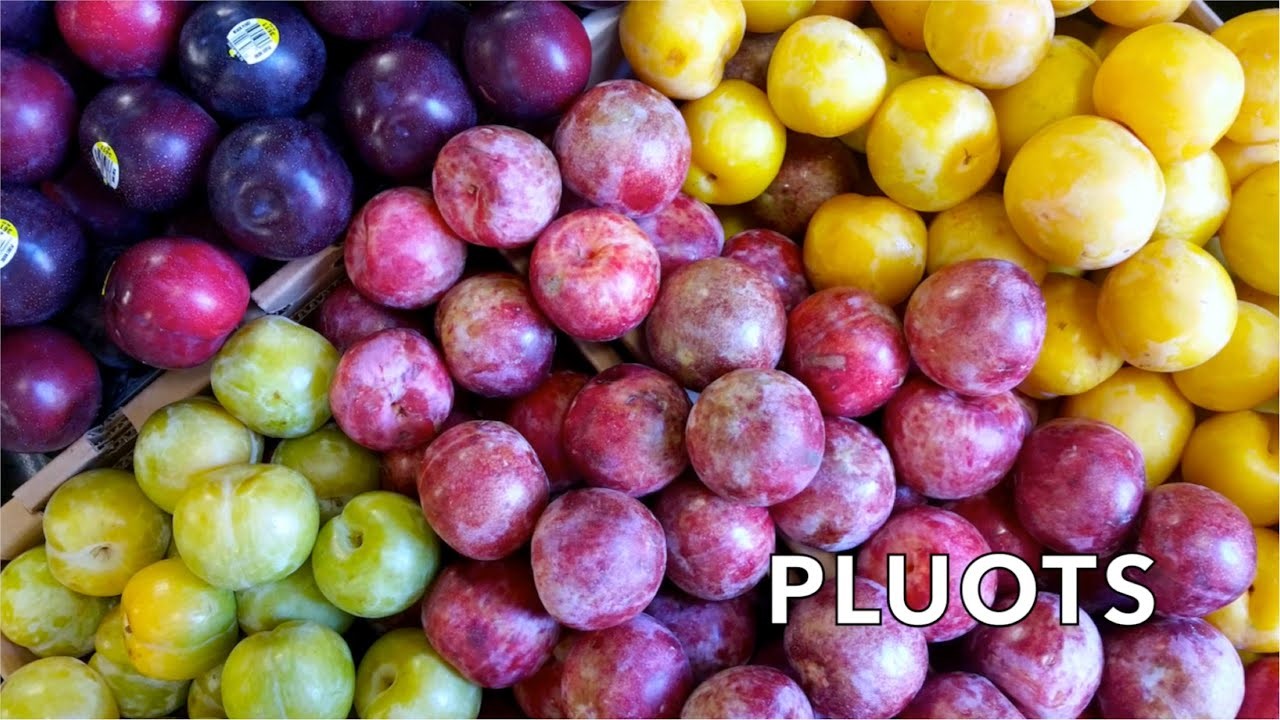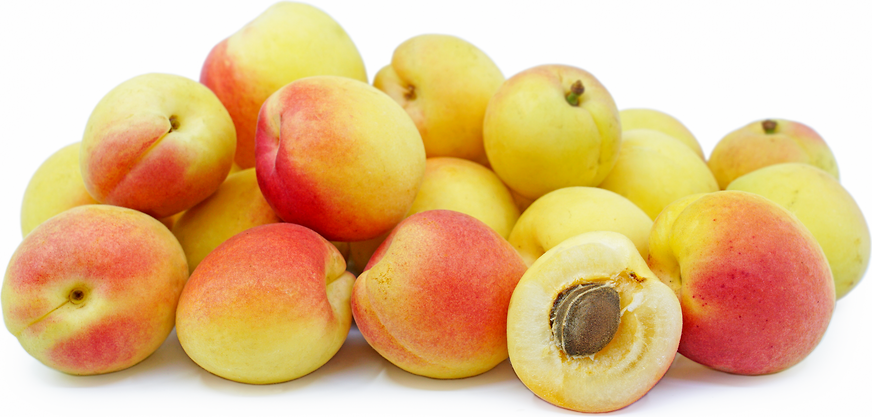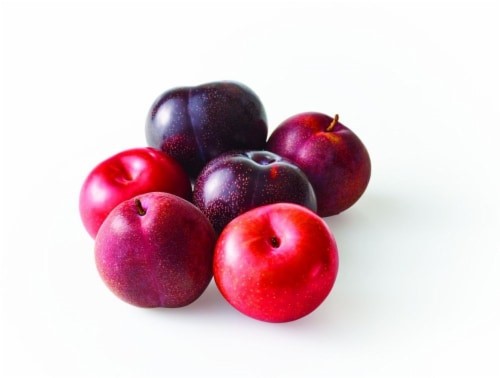Pluots, Apriums, Apriplums, and Plucots...What ARE They?
Did you know that June is National Pluot, Aprium, Apriplum, and Plucot Month? Me neither. Sounds fascinating, though, so I thought it would be fun to learn more about these fruits.
All are plum and apricot hybrids and are typically sweeter than a plum or apricot alone.

First, all about pluots: As you may have already guessed, it’s a hybrid combination of the plum and apricot. It was created in the late 20th century by Floyd Zaiger and is mainly grown in parts of Washington and California.
The pluot has a majority of plum parentage, so its skin is smooth, like the plum. But each variety comes with a delicious sweetness. These varieties vary in size, skin color, and flesh color. The skin can be solid, striped, or speckled and skin colors range from yellow-green to black. Pluot flesh ranges from white to red in color. And speaking of varieties, there are over 20 (Dapple Dandy, Early Dapple, Emerald Drop, Flavor Delight, Flavor Fall, Flavor Finale, Flavor Grenade, Flavor Heart, Flavor Jewel, Flavor King, Flavor Prince, Flavor Penguin, Flavor Queen, Flavor Rich, Flavor Royal, Flavor Supreme, Flavorich, Flavorosa, Geo-Pride, Raspberry Jewel, Red Ray, and Splash).

Next, aprium facts: Because the apricot is the parentage majority, this fruit has only a very slight fuzzy skin and leans more to an apricot flavoring. Currently there are only a few aprium varieties available (Cot-n-Candy, Flavor Delight, Tasty Rich).

Lastly, the apriplum and plumcot: These are actually the same thing. The name plumcot was created by Luther Burbank. And like the aprium and the pluot, they’re a combination of the plum and apricot. This fruit has almost as many varieties as the pluot. Some favorites are Eagle Egg, Amigo, Tropical Plumana, Crimson Sweet, Dapple Jack, Sweet Treat, Flavor Queen, Summer Punch, Tropical Sunrise, King Kong, and Flavor Fall.

The season for these fruits stretches from May to September. They should always be plump and firm and ripened at room temperature before refrigerating. They can also be ripened in a brown paper bag at room temperature.
They are delicious whether eaten fresh or cooked. And there is good reason to indulge in these special fruits. They’re low in calories, high in fiber and nutrients, and have no fat.
I’ll close with my encouragement to try to find these in your grocery store or local farmers’ market, plus a tasty and easy salad recipe using the pluot (found on Jamie Geller’s site, www.jamiegeller.com):
.jpg)
4 pluots pitted and halved
4 cups baby arugula or spring mix
1 cup toasted almonds or pine nuts
honey mustard dressing (your favorite brand or recipe)
Directions:
Add Recipe to Cook'n
blog comments powered by Disqus
All are plum and apricot hybrids and are typically sweeter than a plum or apricot alone.

First, all about pluots: As you may have already guessed, it’s a hybrid combination of the plum and apricot. It was created in the late 20th century by Floyd Zaiger and is mainly grown in parts of Washington and California.
The pluot has a majority of plum parentage, so its skin is smooth, like the plum. But each variety comes with a delicious sweetness. These varieties vary in size, skin color, and flesh color. The skin can be solid, striped, or speckled and skin colors range from yellow-green to black. Pluot flesh ranges from white to red in color. And speaking of varieties, there are over 20 (Dapple Dandy, Early Dapple, Emerald Drop, Flavor Delight, Flavor Fall, Flavor Finale, Flavor Grenade, Flavor Heart, Flavor Jewel, Flavor King, Flavor Prince, Flavor Penguin, Flavor Queen, Flavor Rich, Flavor Royal, Flavor Supreme, Flavorich, Flavorosa, Geo-Pride, Raspberry Jewel, Red Ray, and Splash).

Next, aprium facts: Because the apricot is the parentage majority, this fruit has only a very slight fuzzy skin and leans more to an apricot flavoring. Currently there are only a few aprium varieties available (Cot-n-Candy, Flavor Delight, Tasty Rich).

Lastly, the apriplum and plumcot: These are actually the same thing. The name plumcot was created by Luther Burbank. And like the aprium and the pluot, they’re a combination of the plum and apricot. This fruit has almost as many varieties as the pluot. Some favorites are Eagle Egg, Amigo, Tropical Plumana, Crimson Sweet, Dapple Jack, Sweet Treat, Flavor Queen, Summer Punch, Tropical Sunrise, King Kong, and Flavor Fall.

The season for these fruits stretches from May to September. They should always be plump and firm and ripened at room temperature before refrigerating. They can also be ripened in a brown paper bag at room temperature.
They are delicious whether eaten fresh or cooked. And there is good reason to indulge in these special fruits. They’re low in calories, high in fiber and nutrients, and have no fat.
I’ll close with my encouragement to try to find these in your grocery store or local farmers’ market, plus a tasty and easy salad recipe using the pluot (found on Jamie Geller’s site, www.jamiegeller.com):
Grilled Pluot Salad
.jpg)
Serving size: 4
Calories per serving: 0
Ingredients:
Calories per serving: 0
4 pluots pitted and halved
4 cups baby arugula or spring mix
1 cup toasted almonds or pine nuts
honey mustard dressing (your favorite brand or recipe)
Directions:
Heat grill to medium heat and spray pluots with cooking spray. Grill for two minutes and set aside. Pour dressing over greens and top with pluots and toasted almonds.
Dairy option: serve with crumbled feta or goat cheese.
Dairy option: serve with crumbled feta or goat cheese.
Recipe formatted with the Cook'n Recipe Software from DVO Enterprises.
Sources:
- www.templeofthetongue.com
- www.youtube.com
- www.specialtyproduce.com
- www.kroger.com
- www.jamiegeller.com
 Alice Osborne
Alice Osborne
DVO Newsletter Contributor since 2006
Email the author! alice@dvo.com
